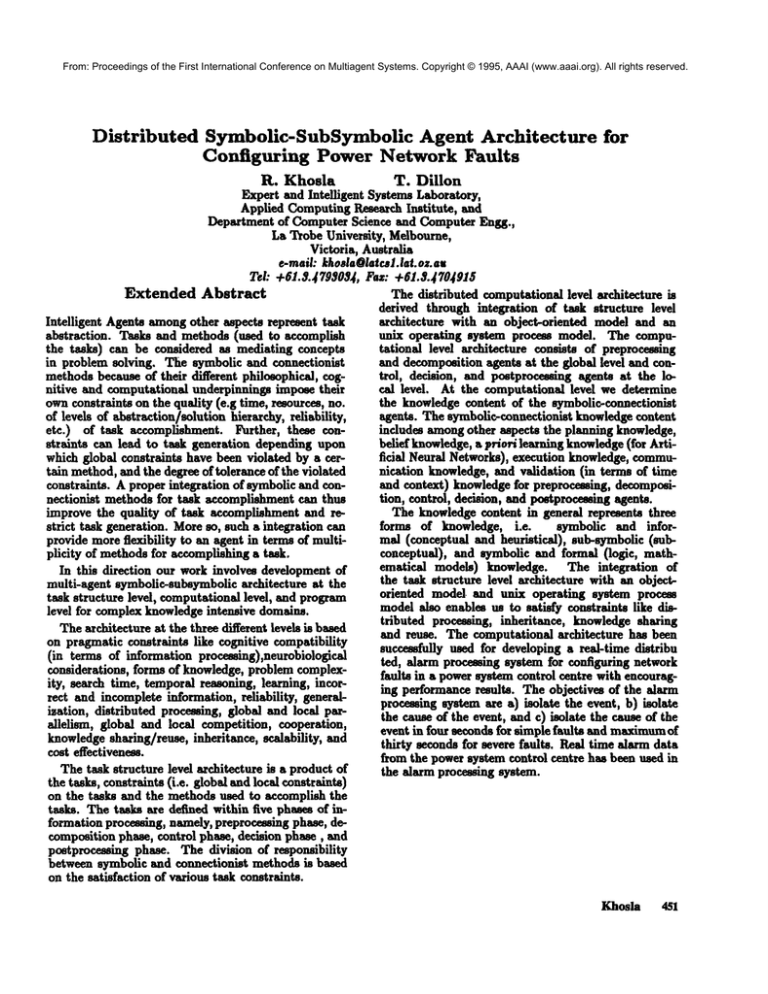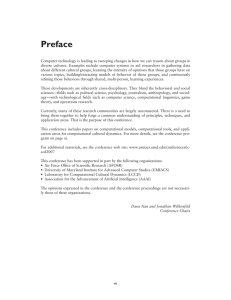
From: Proceedings of the First International Conference on Multiagent Systems. Copyright © 1995, AAAI (www.aaai.org). All rights reserved.
Distributed
Symbolic-SubSymbolic
Agent Architecture
Configuring Power Network Faults
for
R. Khosla
T. Dillon
Expert and Intelligent SystemsLaboratory,
Applied ComputingResearch Institute, and
Department of ComputerScience and ComputerEngg.,
La Trobe University, Melbourne,
Victoria, Australia
e-mail: khosla@laicsl.laf.oz.au
Tel: -I-61.3.4793034, Faz: +61.3.4704915
Extended Abstract
The distributed computational level architecture is
derived through integration of task structure level
Intelligent Agentsamongother aspects represent task
architecture with an object-oriented model and an
unix operating system process model. The compuabstraction. Tasks and methods (used to accomplish
the tasks) can be considered as mediating concepts
tational level architecture consists of preprocessing
in problem solving. The symbolic and ¢onnectionist
and decompositionagents at the global level and conmethodsbecauseof their ditferent philosophical, cogtrol, decision, and postprocessing agents at the local level. At the computational level we determine
nitive and computational underpinnings impose their
the knowledgecontent of the symbolic-connectionist
ownconstraints on the quality (e.g time, resources, no.
agents. The symbolic-connectionist knowledgecontent
of levels of abstraction/solution hierarchy, reliability,
etc.) of task accomplishment. Further, these conincludes amongother aspects the planning knowledge,
straints can lead to task generation dependingupon
belief knowledge,a priori learning knowledge
(for Artiwhichglobal constraints have been violated by a certidal Neural Networks), execution knowledge,commutain method,and the degreeof tolerance of the violated
nication knowledge,and validation (in terms of time
constraints. A proper integration of symbolicand conand context) knowledgefor preprocessing, decomposinectionist methodsfor task accomplishmentcan thus
tion, control, decision, and postprocessingagents.
improve the quality of task accomplishmentand reThe knowledgecontent in general represents three
strict task generation. Moreso, such a integration can
forms of knowledge, i.e.
symbolic and inforprovide moreflexibility to an agent in terms of multims] (conceptual and henristical), sub-symbolic(subplicity of methodsfor accomplishinga task.
conceptual), and symbolic and formal (logic, mathemstical models) knowledge. The integration of
In this direction our work involves developmentof
the task structure level architecture with an objectmulti-agent symbolie-subsymbolicarchitecture at the
oriented model and unix operating system process
task structure level, computationallevel, and progrsm
modelalso enables us to satisfy constraints like dislevel for complexknowledgeintensive domains.
tributed processing, inheritance, knowledgesharing
Thearchitecture at the three different levels is based
and reuse. The computational architecture has been
on pragmatic constraints like cognitive compatibility
successfully used for developinga real-time distribu
(in terms of information processing),neurobiologlcal
ted, alarm processing system for configuring network
considerations, forms of knowledge,problemcomplexfaults in a powersystem control centre with encouragity, search time, temporalreasoning, learning, incoring performanceresults. The objectives of the alarm
rect and incompleteinformation, reliability, generalprocessing system are a) isolate the event, b) isolate
ization, distributed processing, global and local parthe cause of the event, and c) isolate the cause of the
allelism, global and local competition, cooperation,
event in four seconds for simple faults and maximum
of
knowledgeshying/reuse, inheritance, scalability, and
thirty secondsfor severe faults. Real time alarm data
cost effectiveness.
from the powersystem control centre has been used in
Thetask structure level architecture is a product of
the alarm processing system.
the tasks, constraints (i.e. global andlocal constraints)
on the tasks and the methods used to accomplish the
tasks. Thetasks are defined within five phases of information processing, namely, preproceesingphase, decompositionphase, control phase, decision phase, and
postprocessing phase. The division of responsibility
between symbolic and connectionist methodsis based
on the satisfaction of various task constraints.
Khosla 451




